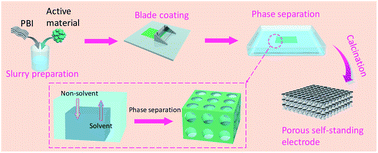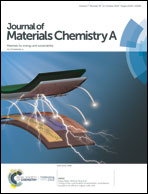Constructing high-performance 3D porous self-standing electrodes with various morphologies and shapes by a flexible phase separation-derived method†
Abstract
Self-standing electrodes have attracted great attention due to their promising applications in advanced electronic devices with high-energy demands. Inspired by the 3D framework and well-controlled porous structure of the porous membrane prepared via the phase separation method, for the first time, a binder-free 3D porous self-standing electrode has been designed and fabricated by using a porous polybenzimidazole (PBI) membrane as the template. Various methods were investigated in detail, in which the ethanol phase separation-derived method resulted in a sponge-like cross section and porous structure of both surfaces, leading to the best electrochemical performance. Meanwhile, considering the carbon content, the optimized self-standing Na3V2(PO4)3@C electrode exhibited excellent rate performance (110.4 mA h g−1 at 0.5C and 108.1 mA h g−1 at 40C) and cycling stability (capacity retention of 90.4% after 2000 cycles at 1C). The superior electrochemical performance can be ascribed to the high electron conductivity due to the 3D N-doped cross-linked carbon matrix and the fast Na+ diffusion in the spongy macro-porous structure. The self-standing electrode prepared via this method exhibited high flexibility in the electrode mass loading, pore structures (sponge-like, finger-like, etc.) and electrode shapes (fiber, coil, spiral, letter, etc.). This phase separation-derived method will greatly promote the development and large-scale application of self-standing electrodes.



 Please wait while we load your content...
Please wait while we load your content...